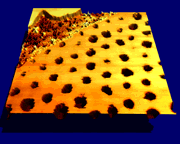Mysterious nanopatterns probed by Sandia team
Get organized!
Scientists have found that nanometer-scale islands of metals and semiconductors deposited on a crystal surface self-organize into ordered arrays. When this process takes place on a single-atom-thick film of silver sprinkled with sulfur, a lacework pattern emerges with surprising precision.

Download 150dpi JPEG image, ‘nano_pix.jpg’, 1 Mb
Karsten Pohl (8716) is a Sandia postdoctoral fellow who has been carefully examining this phenomenon. He says characterizing what drives this process could enable new generations of revolutionary nanostructures whose manufacture rivals the most advanced patterning techniques.
In the lattice-work studied, sulfur atoms pierce the silver "in a spectacular example of self-organization," says Norm Bartelt (8717), a theoretical physicist who statistically analyzed the process. "The individual holes the sulfur digs line up into a perfect lattice." Work by a Sandia team identifying the mechanism of this self-organizing phenomenon is reported in the Jan. 21 Nature.
Each hole is almost 25 times further apart than the field of force exerted by individual atoms. How these distant features interact to form surface patterns was intriguing and mysterious for Norm, Karsten, and collaborators Maria Bartelt (8717) and Juan de la Figuera (8716). They say the answer might allow creation of such devices as computers based on islands of quantum dots.
Collaborators at Sandia were the first to combine statistical analysis and experimental observations to probe the forces governing this self- organization behavior.
They used a scanning tunneling microscope at Sandia that has such good resolution that it was possible to watch clusters of atoms move as the seconds ticked by. The silver film is spread out on the ruthenium substrate into a layer one silver atom deep, which offers a preferred low-energy state. The added sulfur also wants to rest directly on top of the ruthenium to minimize energy.
As they jostled for position during self-organization, groups of sulfur atoms displaced silver atoms and formed islands of sulfur embedded in the silver sheet. The flat ruthenium underneath started to "cup" slightly under the strain as the silver sheets between sulfur islands were distorted to accommodate the sulfur islands. These distortions caused the sulfur islands to repel each other and organize into an ordered pattern.
The forces of this bulk elastic distortion are very weak — about 10,000 times less than the electrical forces that operate at close range between atoms. But the findings still hold promise that by controlling the substrate, the pattern-forming interactions can be controlled and even tuned to create specific patterns.
Patterning at such small scales is extremely difficult, so this propensity for self-organization could present an ultimate approach to making ordered arrangements.
The team has received Laboratory-Directed Research and Development funding to see how general the phenomenon is. For instance, it might be possible to put a different metal in the lattice-work "holes" to make templates for a sensor, says Bob Hwang (8716).
He and visiting collaborator Jan Hrbek of Brookhaven National Laboratory, an expert on sulfur, first examined this system to better understand how sulfur poisons catalytic converters (which clean vehicle emissions) by changing surface structures — a corrosion problem of long interest. However, they did not expect the corrosion to exhibit such an ordered pattern.